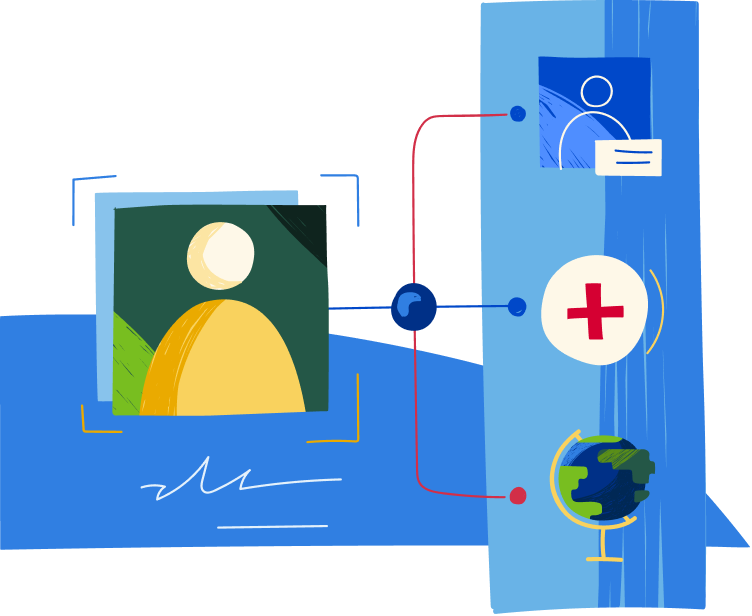Collection and Use of Data to Drive Action

Using quantitative and qualitative data to inform, design, and evaluate improvement strategies.
The Collection and Use of Data to Drive Action Lever Includes:
Data Collection and Validation
How might your hospital collect and validate patient population and community data?
How might your hospital collect and validate patient population and community data?
Our Definition:
Hospitals have a uniform data collection and validation framework to systematically collect demographic data from patients, their caregivers and community served. Hospitals engage with patients and community members to provide input on the data collection and validation process.
- REaL Data: Race, Ethnicity and preferred Language
- SOGI Data: Sexual Orientation and Gender Identity
- SDOH Data: Social Determinants of Health
Where on the continuum is your organization?
Exploring the values and resources needed to publicly commit to embarking upon a journey to achieve health equity.
Hospital conducts an equity assessment of current data collection methods.
Example
All race and ethnicity categories collected, at a minimum, reflect the Office of Management and Budget standards. Hospital uses self-reporting methodology to collect REaL and SOGI data for all patients.
Committing the resources to listen, learn, train and implement policies and practices that establish equity as standard practice.
Hospital collects REaL or SOGI data. Hospital has a plan to address any system-level issues related to the collection of patient’s REaL and SOGI data.
Example
Hospital has a standardized process in place to evaluate and validate the accuracy of patient self-reported demographic data including percent of “unknown,” “unavailable,” or “declined” for REaL data (aiming for a cumulative goal of <5%).
Immersing the leadership and system into accountability for policies, procedures and cultural structures that support diversity, equity and inclusion.
Hospital invests in ways that improve data collection and validation of REaL, SOGI, and SDOH/social risk data. Hospital determination of SDOH/social risk factors is determined by input from the patients and communities it serves.
Example
Hospital looks at opportunities for data verification at multiple points of care (beyond just registration) to ensure data accuracy and to prevent any missed opportunities for data collection (e.g., pre-registration process, registration/admission process, inpatient units, etc.).
Affirming an equitable system culture with continuous equity self-assessments of policies and practices that remove structural barriers to equity.
Hospital collects REaL, SOGI and SDOH/social factors data for at least 95% of patients. Hospital has a standardized process in place to evaluate the accuracy and completeness (percent of fields completed) for REaL, SOGI, and SDOH/social risk data.
Example
The data collected are made available to providers at the point of care to inform treatment plans (e.g., through the EHR). The data are stratified and quality programs/initiatives are launched to address disparities across patient populations.
Transforming beyond the system toward supporting a sustainable and equitable ecosystem of health care within the community.
Hospital equity framework drives comprehensive data collection which includes REaL, SOGI, social factors and value as well as community engagement data. Hospital has a process in place to evaluate and compare its collected patient demographic data to local demographic community data.
Example
Data collection efforts across REaL, SOGI and SDOH are consistently at the 90% threshold or greater. Data are made actionable to drive improvements in patient outcomes. Provider performance data is transparent and unblinded for peers to see and to support coaching and mentoring activities. There is a healthy respect for the power of data to transform processes and guide actions at the provider, department, organizational and community levels.
Data Training
How might you train staff to better support data collection and validation?
How might you train staff to better support data collection and validation?
Our Definition:
Training prepares staff to collect appropriate patient and community data (e.g., race/ethnicity and language preference — “REaL,” sexual orientation and gender identity — “SOGI,” patient social needs, social determinants of health — “SDOH,” etc.), to stratify the data, to identify disparities, to benchmark progress, and to create patient safety/quality improvement plans as part of high reliability health care.
Where on the continuum is your organization?
Exploring the values and resources needed to publicly commit to embarking upon a journey to achieve health equity.
Hospital identifies areas to train staff to support data collection and validation.
Example
Patients and family advisors are included in the development and delivery of workforce training to collect data. Read in detail.
Committing the resources to listen, learn, train and implement policies and practices that establish equity as standard practice.
Hospital provides staff training on REaL and SOGI data collection methods (e.g., observations, teach-back method, post-test, etc.).
Example
Training may include role playing, scripts, didactic, manuals, on-line modules or other tools/job aids.
Immersing the leadership and system into accountability for policies, procedures and cultural structures that support diversity, equity and inclusion.
Hospital provides staff training on REaL, SOGI data and SDOH/social risk data collection.
Example
Hospital staff understand the value of collecting these data and how to make them actionable for their function/role inside the organization.
Affirming an equitable system culture with continuous equity self-assessments of policies and practices that remove structural barriers to equity.
Hospital evaluates the effectiveness of workforce training on an annual basis to ensure staff demonstrates competency in patient self-reporting data collection methodologies.
Example
Hospital conducts a structural barrier analysis and reports its impact on patient safety.
Transforming beyond the system toward supporting a sustainable and equitable ecosystem of health care within the community.
Hospital shares data training and best practices with peer organizations or community partnerships. With community input, hospital conducts yearly assessment of staff competency in patient self-reporting data collection methodologies.
Example
Hospital collaborates with local community organizations representing historically marginalized members of the community to define measures of staff competency.
Data Stratification and Reporting
How might your hospital stratify its patient or community data and communicate progress and findings within the organization and externally?
How might your hospital stratify its patient or community data and communicate progress and findings within the organization and externally?
Our Definition:
Hospitals collect and stratify data to identify disparities and share health outcomes within its organization and externally with the community it serves.
Where on the continuum is your organization?
Exploring the values and resources needed to publicly commit to embarking upon a journey to achieve health equity.
Based on data collected, hospital stratifies more than one patient safety, quality and/or outcome measure by REaL and SOGI to identify potential disparities.
Hospital uses a reporting mechanism to routinely communicate patient population metrics and outcomes to hospital senior executive leadership (including medical staff leadership) and the board.
Example
Hospital uses a framework for stratifying Race, Ethnicity and Language (REaL) data.
Committing the resources to listen, learn, train and implement policies and practices that establish equity as standard practice.
Hospital stratifies patient safety, quality and/or outcome measure by REaL and SOGI to identify potential disparities.
Hospital uses a reporting mechanism to routinely communicate patient population outcomes widely within the organization.
Example
Hospital shares its equity dashboard, which is communicated to appropriate staff members, managers, directors, providers, committees and departments.
Immersing the leadership and system into accountability for policies, procedures and cultural structures that support diversity, equity and inclusion.
Hospital stratifies patient safety, quality and/or outcome measures by REaL, SOGI and SDOH/social risk to identify potential disparities.
Hospital uses a reporting mechanism to communicate patient population outcomes with patients and families and/or other community partners or stakeholders.
Example
Specific metrics to identify disparities among diverse patient populations may include race, ethnicity and language preference, sexual orientation, gender identity, disability status and social needs data.
Affirming an equitable system culture with continuous equity self-assessments of policies and practices that remove structural barriers to equity.
Hospital routinely evaluates data stratification to ensure alignment with its community input/goals.
Hospital uses a reporting mechanism to communicate patient population outcomes with leadership, board, staff, patients and families, and community partners.
Example
The AHA’s Health Equity, Diversity and Inclusion Measures for Hospital and Health System Dashboards can help hospitals and health systems identify metrics to track and monitor.
Transforming beyond the system toward supporting a sustainable and equitable ecosystem of health care within the community.
Hospital uses a reporting mechanism to share/communicate patient population outcomes with other health care organizations and receive input on key metrics, progress and outcomes.
Example
Hospital creates a virtual community dashboard that is linked to community stakeholders’ websites and publications.
DEI Initiatives and Programs
How might you use data to inform and create your DEI initiatives and programs?
How might you use data to inform and create your DEI initiatives and programs?
Our Definition:
Hospital uses data to inform and design DEI initiatives and programs such as addressing social needs or social determinants of health.
Where on the continuum is your organization?
Exploring the values and resources needed to publicly commit to embarking upon a journey to achieve health equity.
Hospital uses data to identify risk areas and opportunities to inform or prioritize initiatives and programs related to DEI.
Example
Hospital uses CHNA processes to identify or prioritize initiatives and programs.
Committing the resources to listen, learn, train and implement policies and practices that establish equity as standard practice.
Hospital uses data to inform DEI improvement goals and projects.
Example
Beginning in 2011, Henry Ford Health System launched an initiative to improve its collection of patient data. In 2020, several of its system hospitals exceeded a goal to collect race, ethnicity and language preference information from more than 90% of patients. The data helped Henry Ford better understand patient barriers to better care outcomes, including housing, transportation and food access. Read in detail.
Immersing the leadership and system into accountability for policies, procedures and cultural structures that support diversity, equity and inclusion.
Hospital establishes metrics for an equity plan for each level: patient, organizational, communal and societal.
Example
Hospital leadership uses equity plan as a benchmarking tool for organizational development and the dismantling of structural barriers.
Affirming an equitable system culture with continuous equity self-assessments of policies and practices that remove structural barriers to equity.
Hospital tracks the progress of DEI initiatives and programs.
Leadership, board, staff, patients and families, and community partners are engaged to review and receive input on key metrics, progress and outcomes.
Example
Hospital creates policies and practices to host an annual event to share DEI progress toward goals.
Transforming beyond the system toward supporting a sustainable and equitable ecosystem of health care within the community.
Hospital allocates funding for community equity initiatives. Hospital calculates its return on investment (ROI) regarding DEI initiatives and programs.
Example
Following its 2010 internal assessment, Cone Health significantly overhauled its culture after a revealing look at how its own staff perceived the organization’s values. Cone Health’s leaders launched a significant effort to address diversity, equity and inclusion and it resulted in innovative changes in the organization.





